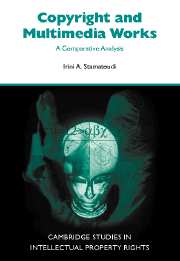Book contents
- Frontmatter
- Contents
- Acknowledgments
- List of abbreviations
- Introduction
- 1 Placing multimedia products within the scope of copyright
- 2 The scope of multimedia works
- 3 Traditional literary works
- 4 Collections and compilations
- 5 Databases
- 6 Audiovisual works
- 7 Computer programs
- 8 Video games as a test case
- 9 Multimedia products and existing categories of copyright works
- 10 A regime of protection for multimedia products
- 11 Conclusions
- Postscript
- Bibliography
- Index
3 - Traditional literary works
Published online by Cambridge University Press: 25 July 2009
- Frontmatter
- Contents
- Acknowledgments
- List of abbreviations
- Introduction
- 1 Placing multimedia products within the scope of copyright
- 2 The scope of multimedia works
- 3 Traditional literary works
- 4 Collections and compilations
- 5 Databases
- 6 Audiovisual works
- 7 Computer programs
- 8 Video games as a test case
- 9 Multimedia products and existing categories of copyright works
- 10 A regime of protection for multimedia products
- 11 Conclusions
- Postscript
- Bibliography
- Index
Summary
Originally copyright was meant as a regime of protection for literary works. Literary works, seen as a generic term, really refers to most oral and written works of the mind, which are expressed by means of language and which can be literary, scientific or of any other nature. To take two examples only, Belgian copyright law refers to literary works as écrits de tout genre (writings of any kind), and as manifestations orales de la pensée (oral expressions of the mind), whilst the Swiss Act refers to them as créations de l'esprit (creations of the mind). The UK's Copyright Designs and Patents Act 1988 refers to a literary work as simply ‘any work … which is written, spoken or sung’.
What we usually understand as literary works are books, articles, pamphlets, lectures, sermons and other works of the same nature.
LITERARY WORKS AS WORKS OF LANGUAGE
The concepts of ‘language’ and ‘words’
The key feature of literary works is the fact that they are conceived in language. The final format can be written, recorded or oral. In other words, genuine literary works are, in their original format, either spoken or written, and are created in order to be listened to or read. If their primary aim were not this one, but were for visual or musical performance, or display, they would strictly speaking not be literary works, though they would still come within the category of literary works in the broad sense. This includes dramatic, musical, pictorial or artistic works.
- Type
- Chapter
- Information
- Copyright and Multimedia ProductsA Comparative Analysis, pp. 42 - 70Publisher: Cambridge University PressPrint publication year: 2001



